
The state of New York is in the process of adding plug-in hybrid vehicles to its state fleet, through the purchase of new units and the conversion of its current fleet to electric power.

The state of New York is in the process of adding plug-in hybrid vehicles to its state fleet, through the purchase of new units and the conversion of its current fleet to electric power.
The New York State Energy Research and Development Authority, NYSERDA, is a public benefit corporation created in 1975 under Article 8, Title 9 of the State Public Authorities Law through the reconstitution of the New York State Atomic and Space Development Authority. Their goal is to reduce New York Emissions and create/research new technologies to do so. [1]
The Electric Power Research Institute(EPRI) conducts research relating to the generation, delivery and use of electricity. [2]

NYSERDA has begun a study on the effects of plug-in hybrids on the power grid; plug-in hybrids save a lot of gas around 100 mpg, but plugging them into the grid outs a lot of pressure on the grid and makes it hard and aggravating on the power grid. The study include:
Some quotes from workers at these organizations about this study: "Our analysis will develop the definitive assessment of the impact of both introducing and the widespread use of plug-in hybrid vehicles onto the transmission and distribution systems," said Arshad Mansoor, vice president of power delivery and utilization at EPRI. "This grid assessment is another crucial step that will lead to commercialization of plug-in hybrid vehicles," he said, "and NYSERDA deserves a lot of credit for taking this important initiative." [3]
On August 2, 2006, New York Governor George E. Pataki and State Senate Majority Leader Joseph Bruno announced plans for a new $10-million State program to convert vehicles in the State fleet to plug-in hybrids. Inside the $10 million is 600 state hybrids that will be converted to plug-ins. Also the New York State Alternative Fuel Vehicle Research Laboratory will conduct testing for technologies such as fuel cell systems, alternative fuels, and greenhouse gas reduction technologies. In addition, focus will be given to the public transportation systems to make them more efficient. [4] The first Plug-in hybrid was added to the fleet on December 20, 2006. [5]

A motor vehicle, also known as motorized vehicle or automotive vehicle, is a self-propelled vehicle, commonly wheeled, that does not operate on rails and is used for the transportation of people or cargo.

A hybrid vehicle is one that uses two or more distinct types of power, such as submarines that use diesel when surfaced and batteries when submerged. Other means to store energy include pressurized fluid in hydraulic hybrids.
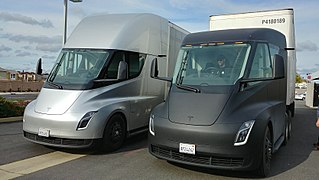
An electric vehicle (EV) is a vehicle that uses one or more electric motors or traction motors for propulsion. An electric vehicle may be powered through a collector system by electricity from off-vehicle sources, or may be self-contained with a battery, solar panels, fuel cells or an electric generator to convert fuel to electricity. EVs include, but are not limited to, road and rail vehicles, surface and underwater vessels, electric aircraft and electric spacecraft.

A green vehicle, clean vehicle, eco-friendly vehicle or environmentally friendly vehicle is a road motor vehicle that produces less harmful impacts to the environment than comparable conventional internal combustion engine vehicles running on gasoline or diesel, or one that uses certain alternative fuels. Presently, in some countries the term is used for any vehicle complying or surpassing the more stringent European emission standards, or California's zero-emissions vehicle standards, or the low-carbon fuel standards enacted in several countries.

A plug-in hybrid electric vehicle (PHEV) is a hybrid electric vehicle whose battery can be recharged by plugging a charging cable into an external electric power source, in addition to internally by its on-board internal combustion engine-powered generator. Most PHEVs are passenger cars, but there are also PHEV versions of commercial vehicles and vans, utility trucks, buses, trains, motorcycles, mopeds, and even military vehicles.
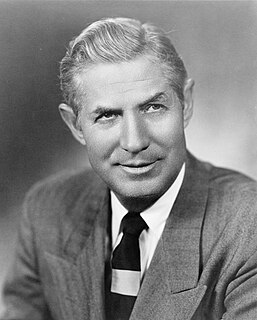
The Monroney sticker or window sticker is a label required in the United States to be displayed in all new automobiles and includes the listing of certain official information about the car. The window sticker was named after Almer Stillwell "Mike" Monroney, United States Senator from Oklahoma. Monroney sponsored the Automobile Information Disclosure Act of 1958, which mandated the disclosure of equipment and pricing information on new automobiles.
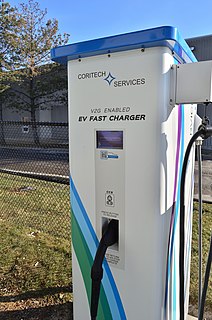
Vehicle-to-grid (V2G) describes a system in which plug-in electric vehicles (PEV), such as battery electric vehicles (BEV), plug-in hybrids (PHEV) or hydrogen fuel cell electric vehicles (FCEV), communicate with the power grid to sell demand response services by either returning electricity to the grid or by throttling their charging rate. V2G storage capabilities can enable EVs to store and discharge electricity generated from renewable energy sources such as solar and wind, with output that fluctuates depending on weather and time of day.
Hybrid vehicle drive trains transmit power to the driving wheels for hybrid vehicles. A hybrid vehicle has multiple forms of motive power.

A hybrid electric vehicle (HEV) is a type of hybrid vehicle that combines a conventional internal combustion engine (ICE) system with an electric propulsion system. The presence of the electric powertrain is intended to achieve either better fuel economy than a conventional vehicle or better performance. There is a variety of HEV types and the degree to which each function as an electric vehicle (EV) also varies. The most common form of HEV is the hybrid electric car, although hybrid electric trucks, buses, boats and aircraft also exist.

An alternative fuel vehicle is a motor vehicle that runs on alternative fuel, an energy other than traditional petroleum fuels ; and also refers to any technology of powering an engine that does not involve solely petroleum. Because of a combination of factors, such as environmental concerns, high oil prices and the potential for peak oil, development of cleaner alternative fuels and advanced power systems for vehicles has become a high priority for many governments and vehicle manufacturers around the world.

CalCars was a charitable, non-profit organization founded in 2002 to promote plug-in hybrid electric vehicles (PHEVs) as a key to addressing oil dependence and global warming both nationally and internationally. It was active until 2010, when the first mass-produced PHEVs arrived. CalCars envisioned millions of plug-in hybrid electric vehicles, charged by off-peak electricity from renewable energy sources, and with their internal combustion engines powered by low-carbon alternative fuels, as a way to significantly reduce greenhouse gases that come from transportation.

The history of plug-in hybrid electric vehicles (PHEVs) spans a little more than a century, but most of the significant commercial developments have taken place after 2002. The revival of interest in this automotive technology together with all-electric cars is due to advances in battery and power management technologies, and concerns about increasingly volatile oil prices and supply disruption, and also the need to reduce greenhouse gas emissions. Between 2003 and 2010 most PHEVs on the roads were conversions of production hybrid electric vehicles, and the most prominent PHEVs were aftermarket conversions of 2004 or later Toyota Prius, which have had plug-in charging and more lead-acid batteries added and their electric-only range extended.

RechargeIT is one of five initiatives within Google.org, the charitable arm of Google, created with the aim to reduce CO2 emissions, cut oil use, and stabilize the electrical grid by accelerating the adoption of plug-in electric vehicles.

A battery electric vehicle (BEV), pure electric vehicle, only-electric vehicle or all-electric vehicle is a type of electric vehicle (EV) that exclusively uses chemical energy stored in rechargeable battery packs, with no secondary source of propulsion. BEVs use electric motors and motor controllers instead of internal combustion engines (ICEs) for propulsion. They derive all power from battery packs and thus have no internal combustion engine, fuel cell, or fuel tank. BEVs include – but are not limited to – motorcycles, bicycles, scooters, skateboards, railcars, watercraft, forklifts, buses, trucks, and cars.

A plug-in electric vehicle (PEV) is any road vehicle that can be recharged from an external source of electricity, such as wall sockets, and the electricity stored in the rechargeable battery packs drives or contributes to drive the wheels. PEV is a subset of electric vehicles that includes all-electric, or battery electric vehicles (BEVs), and plug-in hybrid vehicles (PHEVs). In China, plug-in electric vehicles are classified as new energy vehicles (NEVs). Sales of the first mass-production plug-in cars by major carmakers began in late December 2010, with the introduction of the all-electric Nissan Leaf and the plug-in hybrid Chevrolet Volt.

The adoption of plug-in electric vehicles in the United States is supported by the American federal government, and several states and local governments. As of December 2020, cumulative sales in the U.S. totaled 1.74 million highway legal plug-in electric cars since 2010, led by all-electric cars with more than 1 million units sold. The American stock represented 20% of the global plug-in car fleet in use by the end of 2019, and the U.S. had the world's third largest stock of plug-in passenger cars after China (47%) and Europe (25%).
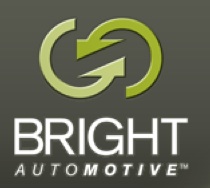
Bright Automotive was a startup company in Anderson, Indiana, working to create a fuel-efficient line of plug-in electric vehicles. The company was started in 2008 with a team of employees from former companies such as Chrysler, Delphi, GM, Mazda, and Toyota. The company designed its first vehicle, the IDEA, a plug-in hybrid electric fleet vehicle designed to reduce fuel costs for corporations that maintain a large commercial fleet. Bright also had a service branch called eSolutions that focused on speeding up the process of car electrification with consulting and conversions. Bright's last CEO, Reuben Munger, stated in early press releases that he wished to see the IDEA in production by 2013.

The Toyota Prius Plug-in Hybrid is a plug-in hybrid liftback manufactured by Toyota. Deliveries of the production model began in Japan in January 2012, in late February in the United States, and by late June 2012 in Europe. The second generation model was first available in 2016 and is currently being produced.

The stock of plug-in electric vehicles in California is the largest in the United States, with cumulative sales of almost 835,000 plug-in cars by the end of 2020. California is the largest U.S. car market with about 10% of all new car sales in the country, but has accounted for almost half of all plug-in cars sold in the American market since 2011. Since November 2016, China is the only country market that exceeds California in terms of cumulative plug-in electric car sales.
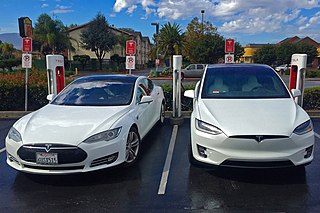
Electric cars have different environmental impacts compared to conventional internal combustion engine vehicles (ICEVs). While aspects of their production can induce similar, less or alternative environmental impacts, some models produce little or no tailpipe emissions, and some have the potential to reduce dependence on petroleum and greenhouse gas emissions, depending on the source of electricity used to charge them, and health effects from air pollution. Electric motors are significantly more efficient than internal combustion engines and thus, even accounting for typical power plan efficiencies and distribution losses, less energy is required to operate an EV. Producing batteries for electric cars requires additional resources and energy, so they may have a larger environmental footprint from the production phase. EVs also generate different impacts in their operation and maintenance. EVs are typically heavier and could produce more tire, brake, and road dust, but their regenerative braking could reduce brake particulate pollution. EVs are mechanically simpler, which reduces the use and disposal of engine oil.